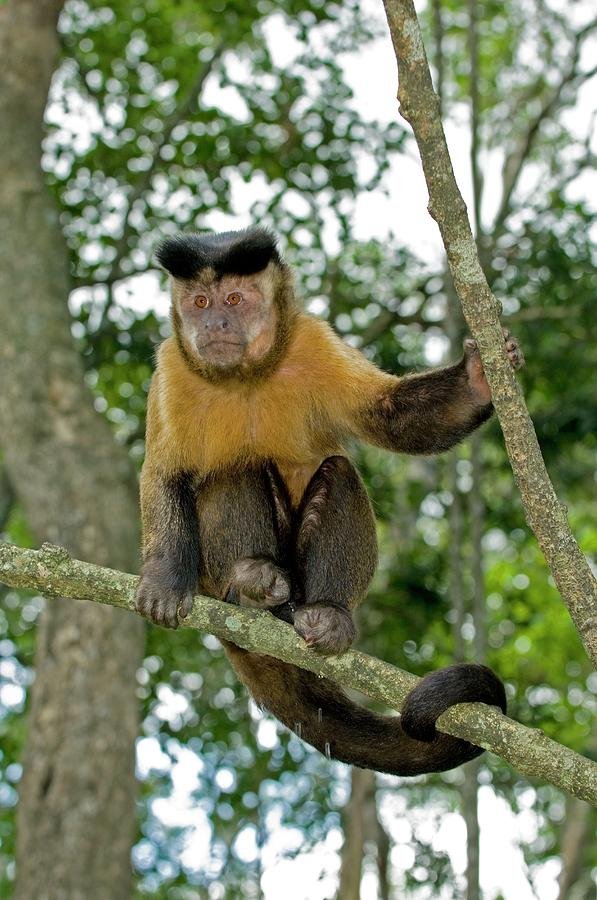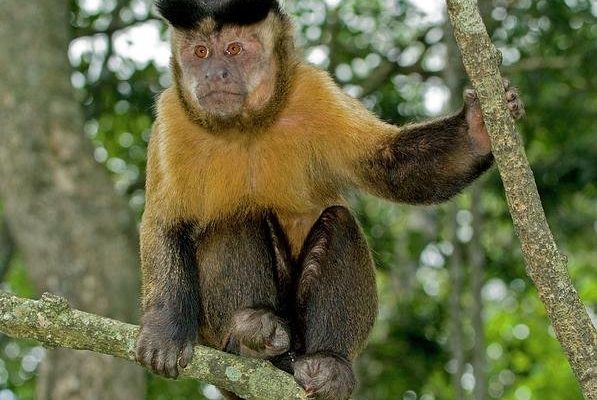
Imagine the tufted capuchin as a tiny gardener of the lush forest. Its daily life involves foraging for fruits, seeds, and insects, which not only provides it with nourishment but also shapes the environment around it. So, let’s dive into the fascinating ways the tufted capuchin interacts with its surroundings and why that matters to the entire ecosystem.
What Are Tufted Capuchins?
The tufted capuchin monkey, known scientifically as *Sapajus apella*, is a small to medium-sized monkey characterized by its distinctive tuft of hair on top of its head. They typically weigh between 3 to 8.5 pounds and can be found living in various habitats, including tropical rainforests, savannas, and even coastal mangroves. With their long limbs and prehensile tails, they’re incredibly agile and can easily navigate through the trees.
These monkeys are highly social animals, often living in groups of 10 to 30 individuals. They communicate with each other using a variety of vocalizations, facial expressions, and body language. You might be wondering how this social structure helps them thrive: the group dynamics allow for better protection from predators, sharing of resources, and cooperative foraging.
Seed Dispersers: A Vital Role
One of the most significant contributions tufted capuchins make to their ecosystem is their role as seed dispersers. As they snack on fruits, they swallow the seeds, which sometimes pass through their digestive systems unharmed. When the capuchins move around the forest, they help spread these seeds through their waste, effectively planting new trees in different locations.
This process is crucial for maintaining the biodiversity of the rainforest. Every time a tufted capuchin eats a fruit, it’s not just feeding itself—it’s also contributing to the growth of plants that other animals rely on for food and shelter. It’s like nurturing a community garden where each plant supports the health of the others.
Pollination Partners
While capuchins are not primary pollinators, they can accidentally assist in pollination as they forage for nectar and fruits. When they visit flowers to eat, they can transfer pollen from one bloom to another, enabling plant reproduction. Although animals like bees and butterflies are the stars of the pollination show, the tufted capuchin plays its part in keeping the cycle of life going.
You might think of it as a casual side job: while they’re enjoying a snack, they’re also helping plants flourish. This is essential for a thriving ecosystem, as diverse plant life supports various animal species, including insects, birds, and other mammals. Each interaction between species in the forest creates a beautifully woven tapestry of life.
An Indicator of Ecosystem Health
The presence of tufted capuchins can be a good indicator of the overall health of their ecosystem. Since these monkeys are sensitive to changes in their environment, their population levels can reveal how healthy the forest is. When capuchins are thriving, it usually means that the forest is rich in food sources and biodiversity. Conversely, a decline in their population may signal problems like deforestation or habitat loss.
By studying tufted capuchin populations, researchers can gain insights into the health of the rainforests they inhabit. It’s similar to reading the mood of a room based on the reactions of its occupants—one can often tell if something is wrong by observing the behavior of the capuchins.
Thriving on Fruit: Dietary Contributions
Tufted capuchins primarily feed on fruits, seeds, nuts, and insects. This wide-ranging diet not only sustains the monkeys but also contributes to the health of the forest. When they consume fruits, they help in the germination process of seeds, as we mentioned earlier. Plus, their foraging behavior encourages a dynamic environment where plants and animals coexist harmoniously.
Here’s where it gets interesting: capuchins can actually influence which plants thrive in their habitat based on their feeding preferences. For example, if they favor certain fruit-bearing trees, those species may proliferate more than others, shaping the forest landscape over time. It’s a delicate balance that highlights the interconnected nature of life in the rainforest.
Social Structure and Ecosystem Impact
The social structure of tufted capuchins has implications beyond their immediate group. By living in larger social groups, they provide protection and support for each other, increasing their chances of survival. This tight-knit community can also create a ripple effect in the ecosystem.
When capuchins forage together, they can access more food sources, thereby reducing pressure on specific plants. This behavior helps prevent overconsumption and promotes biodiversity within the forest. It’s like a team effort, where sharing resources not only benefits the individual monkeys but also helps maintain a balanced ecosystem.
Threats to the Tufted Capuchin and Their Ecosystem
Unfortunately, tufted capuchins face several threats in their natural habitats. Deforestation for agriculture and urban development poses significant challenges. As their homes shrink, these monkeys struggle to find food, leading to declining populations.
Another threat comes from the illegal pet trade, where capuchins are often captured and sold as exotic pets. This practice can devastate local populations and disrupt social structures, making it even harder for these monkeys to thrive.
Addressing these issues is not just about protecting the tufted capuchin but also about safeguarding the entire ecosystem they inhabit. Their role as seed dispersers and pollinators ties them intrinsically to the health of the forest. Without them, the delicate balance of life in the rainforest could be severely impacted.
In the grand story of the rainforest, tufted capuchins play a crucial role that goes far beyond their cute looks and playful behavior. They act as seed dispersers, pollinators, and indicators of ecosystem health, all while contributing to the balance and vibrancy of their environment. Protecting these remarkable monkeys means protecting the rich, diverse ecosystems they help sustain.
So, the next time you hear about a tufted capuchin, remember—it’s not just a monkey. It’s a vital piece of the ecological puzzle, ensuring the tropical rainforests continue to thrive for generations to come. Let’s support conservation efforts that safeguard their habitats, because these little gardeners of the forest deserve a future where they can continue to flourish.

